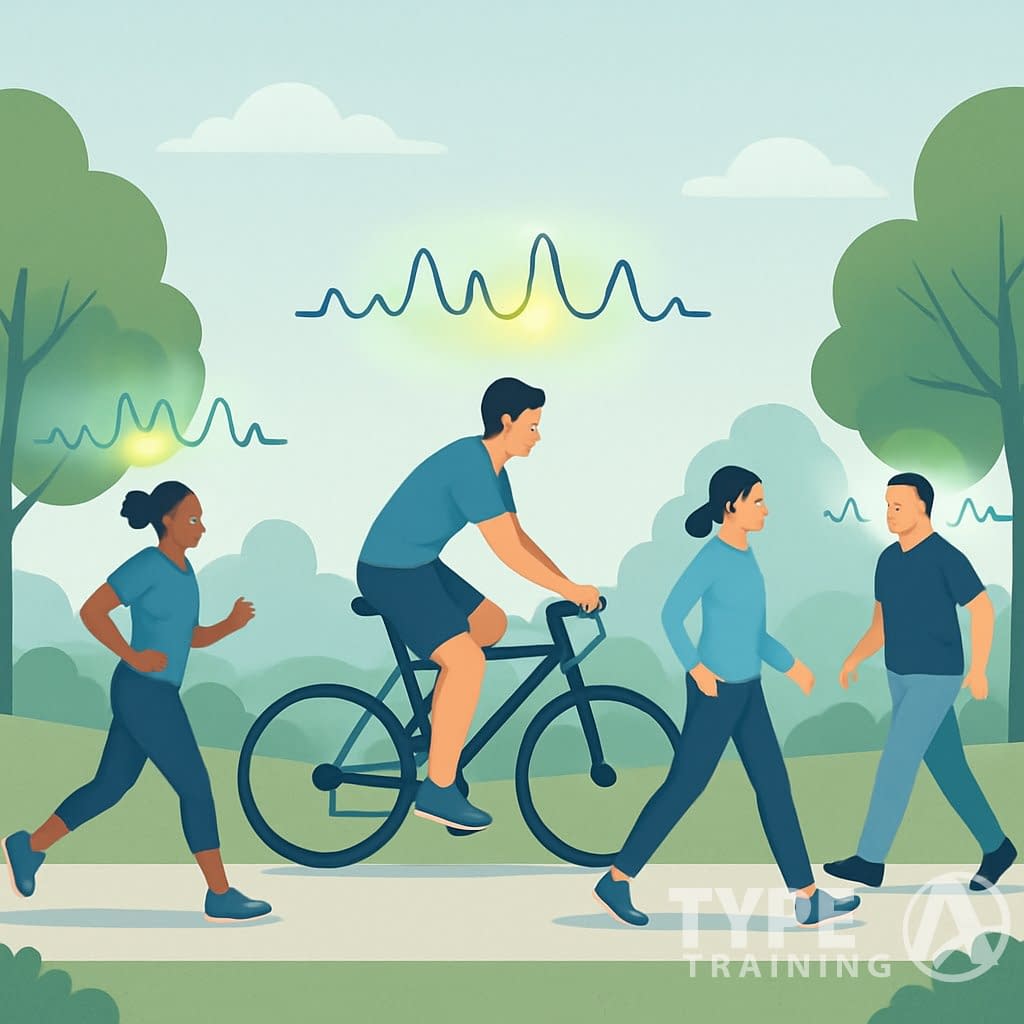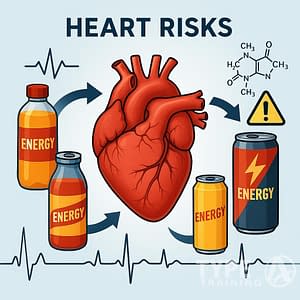If you’ve scrolled through fitness social media lately, you can’t miss all the buzz about Zone 2 cardio. It’s not just another fleeting fad—there’s actually something to it.
Zone 2 cardio means doing low-intensity exercise where your heart rate sits between 60% and 70% of your max. That way, your body mainly burns fat for fuel and you build endurance without feeling wrecked.

Elite athletes have used this approach for ages, but now everyone’s catching on because you get real benefits—without the exhaustion of all-out HIIT. During Zone 2, you can still chat with a workout buddy, so it’s doable for just about anyone.
Popular posts:
People love Zone 2 for the health perks that go way beyond weight loss. Regular sessions can make your heart stronger, boost your mitochondria, and help you recover better—all while being much gentler than most intense workouts.
Key Takeaways
- Zone 2 cardio happens at 60-70% of your max heart rate, letting you burn fat and keep a conversation going.
- This method makes your heart more efficient and keeps it stretchy and strong.
- You can do Zone 2 with walking, cycling, swimming—pretty much anything steady—so it’s easy to fit into any routine.
What Is Zone 2 Cardio?

Zone 2 cardio is a sweet spot in cardio training that brings some unique benefits. You keep your heart rate in that moderate range, which helps you build endurance and train your metabolism.
Defining Zone 2 Cardio
Zone 2 means exercising at about 60-70% of your max heart rate. At this level, your workout feels pretty manageable—you can talk, though you might need to pause for breath here and there.
People also call this the fat burning zone since your body mainly taps into fat for energy. Some go-to Zone 2 activities:
- Brisk walking
- Light jogging
- Cycling at a steady pace
- Swimming at a moderate intensity
- Elliptical workouts
The trick is to hold that moderate pace for 30-60 minutes at a time. That’s where the magic happens.
How Heart Rate Zones Are Determined
Heart rate zones come from your maximum heart rate (MHR), which you can estimate by subtracting your age from 220. It’s not perfect, but close enough for most of us.
Here’s a quick breakdown:
| Zone | Percentage of MHR | Exercise Intensity |
|---|---|---|
| Zone 1 | 50-60% | Very light |
| Zone 2 | 60-70% | Light to moderate |
| Zone 3 | 70-80% | Moderate to hard |
| Zone 4 | 80-90% | Hard |
| Zone 5 | 90-100% | Maximum effort |
If you want to be precise, grab a heart rate monitor or fitness watch. Or, go all out and get tested by a pro. That way, you know you’re really in the right zone.
Understanding Exercise Intensity
Exercise intensity is just how hard you’re working. In Zone 2, you’re putting in steady effort, but it doesn’t feel overwhelming.
The “talk test” is a handy trick: you should be able to speak in full sentences, but singing? Probably not. Your breathing is deeper, but not gasping.
This level boosts your oxygen capacity and helps your body clear lactic acid, so you recover faster.
Building your aerobic base and improving metabolic health is where Zone 2 shines. Unlike HIIT, you can do this type of workout more often, and it’s less likely to leave you sore or burnt out. Honestly, it’s a great fit for most people who want better cardio fitness.
The Science Behind Zone 2 Cardio
Zone 2 cardio works because of some cool biology going on under the hood. When you exercise at this intensity, your body shifts how it makes energy, and you get some unique benefits.
Physiological Effects on the Body
During Zone 2, your heart rate hangs out between 60-70% of max, which is perfect for aerobic metabolism. Your muscles get more blood, but you don’t trigger the stress response that comes at higher intensities.
You barely make any lactate at this level, so you can keep going for a long time. That’s a big part of why the training benefits add up.
Zone 2 also helps your cardiovascular system by:
- Making your heart muscle stronger
- Improving flexibility in your blood vessels
- Increasing your total blood volume
- Helping your body deliver more oxygen to your tissues
Stick with it, and these changes make exercise feel easier over time.
Role of Mitochondria and Fat Oxidation
Your mitochondria—those little energy factories—multiply and get better at their job when you train in Zone 2. It’s called mitochondrial biogenesis, and it’s a game-changer for metabolic health.
In Zone 2, your body:
- Builds more mitochondria
- Improves how well those mitochondria work
- Gets better at burning fat for fuel
With more mitochondria, your muscles use oxygen and fat more efficiently, so you save your glycogen for when you really need it.
That boost in fat burning doesn’t just help during workouts—it can help with weight management even at rest. Pretty useful, right?
Lactate Threshold and Fat as Fuel
Zone 2 sits just below your lactate threshold—that tipping point where your body starts making more lactate than it can clear. That’s why it’s often called the fat burning zone.
In this state, here’s what’s happening:
- About 70% of your energy comes from fat
- You’re not using up tons of carbs
- Lactate stays low (under 2 mmol/L)
Your body gets really good at using fat for energy. Over time, your lactate threshold creeps higher, so you can work harder while still burning mostly fat.
Why Is Zone 2 Cardio Trending Online?
Zone 2 cardio is blowing up online because it offers a realistic, sustainable way to build endurance and burn fat. The best part? It’s approachable for all kinds of people and goals.
Popularity Among Endurance Athletes
Endurance athletes have known about Zone 2 for years, but now the secret’s out. Marathoners, cyclists, and triathletes rely on lots of Zone 2 work to build aerobic power.
What’s the draw? Training in this zone helps your body get better at using fat for energy, which is huge for those long events.
Coaches often say athletes should spend about 80% of their training in Zone 2. This “80/20 rule” builds a strong cardio base and reduces the risk of injury or burnout from too much high-intensity stuff.
Social Media Trends and Influencers
Fitness influencers have jumped on the Zone 2 bandwagon, sharing their own results and routines. The simplicity makes it easy to post about—no crazy equipment or fancy moves required.
On Instagram, TikTok, and YouTube, #Zone2Cardio racks up millions of views. Influencers like it because, honestly, it’s a lot more enjoyable than killing yourself with sprints every day.
It sticks because anyone can try it. You don’t need to be an athlete, and you don’t need special gear. That’s probably why Zone 2’s become such a hit beyond the hardcore gym crowd.
Comparison to High-Intensity Training
Zone 2 training brings a welcome shift from the HIIT craze that’s been everywhere for years. Instead of short, punishing sprints, Zone 2 is all about steady, moderate effort you can actually enjoy—or at least tolerate.
People tend to like Zone 2 for a few reasons:
- It’s less intimidating than HIIT
- Recovery is quicker
- It’s easier to stick with for longer stretches
- Your joints and muscles get a break
Your body taps into different fuel sources depending on your workout style. HIIT chews through carbs, but Zone 2 training leans on fat as its main fuel.
That’s a big draw for folks chasing fat loss or hoping to boost metabolic health. Zone 2 also fits nicely alongside strength training.
Weightlifters have figured out it helps keep their hearts flexible, which can get tricky if you’re always lifting heavy.
Health Benefits of Zone 2 Cardio
Zone 2 cardio delivers some standout health perks that go way beyond just burning a few extra calories. This moderate approach strengthens your heart and helps you bounce back faster—and, honestly, might even help you stick around longer.
Heart Health and Cardiovascular Disease Prevention
Zone 2 training really gives your heart a boost by making it more efficient. When you’re in this zone, your heart pumps more blood with each beat.
That means your stroke volume improves, and over time, your resting heart rate drops. You’ll also notice your stamina and endurance climbing as your body gets better at using oxygen.
All of this puts less strain on your heart, even when you’re just living your daily life. Zone 2 cardio can help ward off cardiovascular disease by:
- Making blood vessels more elastic
- Lowering
blood pressure - Reducing inflammation
- Improving cholesterol numbers
Just 30-40 minutes of Zone 2 a couple times a week can do a lot for your heart, especially if you’re already active. It’s not about going harder—it’s about showing up regularly.
Longevity and Recovery
Zone 2 is often called the fat burning zone, since your body mostly uses fat for energy at this pace. But the benefits go deeper than that.
Your mitochondria—the little engines in your cells—multiply and work better with regular Zone 2 training. That cellular upgrade might actually slow down some aging processes. Pretty wild, right?
On recovery days, Zone 2 shines. It:
- Boosts blood flow without wearing you out
- Helps clear out metabolic junk
- Makes it easier to train often without feeling wrecked
Zone 2 can lift your mood and mental health, too. The manageable intensity lets you stay consistent, which is perfect for those in-between days when you’re not up for going all out.
Performance and Fitness Improvements
Zone 2 cardio isn’t just for people who want to lose weight or stay healthy—it’s a legit game-changer for athletic performance. Training in this zone helps your body use oxygen better and go the distance, literally.
VO2 Max and Aerobic Capacity
Working in Zone 2 can bump up your VO2 max, which is basically how much oxygen your body can use when things get tough. You get there by consistently putting in Zone 2 work.
Your heart learns to pump more blood per beat, so your muscles get more oxygen whether you’re chilling or pushing hard. On top of that, Zone 2 training packs your muscles with more mitochondria—the cell’s powerhouses.
More mitochondria mean better aerobic capacity. The cool part? You don’t have to crush yourself to see these benefits.
Endurance and Performance Gains
Stick with Zone 2 cardio, and you’ll notice your endurance and fat-burning ability go up. Your body learns to use fat for fuel and saves precious glycogen for when you really need it.
This efficiency pays off during long workouts or races. You can keep going without hitting the wall so soon.
Zone 2 also helps you bounce back between hard sessions, so you can train more often without burning out. Strength athletes add Zone 2 to keep their hearts flexible—heavy lifting can stiffen things up otherwise.
It’s honestly a pretty sustainable way to build lasting performance. You can do Zone 2 cardio regularly without worrying about overdoing it.
Zone 2 Cardio for Fat Loss and Body Composition
Zone 2 cardio has caught on for good reason when it comes to fat loss and body composition. If you want to burn fat and keep your muscle, this style of training is tough to beat.
Calories Burned and Fat Burning
When you’re in Zone 2, your body mostly burns fat for energy. That’s because you’re working at about 60-70% of your max heart rate—right where fat metabolism is most efficient.
High-intensity workouts torch more calories in the moment, but Zone 2 is especially good for fat loss. If you’re aiming to manage your weight, that’s a big plus.
Shoot for at least 150 minutes of Zone 2 each week. Break it up into five 30-minute sessions if that fits your schedule.
Here’s how you know you’re in Zone 2:
- Heart rate sits at 60-70% of your max
- You can still chat with a friend
- It feels a little challenging, but you could keep going
Role in Improving Body Composition
Zone 2 helps you drop fat without losing muscle. Unlike some high-intensity routines, these workouts are gentle enough to protect your gains.
You’ll also see your cardiovascular fitness improve, so your body gets better at using oxygen and nutrients. That means you’ll burn fat more efficiently all day long.
Some great Zone 2 activities:
- Brisk walking
- Easy swimming
- Light cycling
- Elliptical training
These low-impact options are sustainable for longer workouts, which is perfect for maximizing fat loss without feeling wrecked.
How to Determine Your Zone 2 Heart Rate
Dialing in your Zone 2 heart rate is key if you want to get the most out of your training—whether it’s for endurance, fat loss, or just feeling better. Luckily, figuring it out isn’t rocket science.
Calculating Maximum and Target Heart Rate
Start by finding your max heart rate (MHR). The classic formula is 220 minus your age. So, if you’re 40, your MHR is about 180 beats per minute.
Zone 2 usually sits between 60-70% of your max. Here’s how you get your range:
- Calculate your MHR (220 – age)
- Multiply by 0.6 for the low end
- Multiply by 0.7 for the high end
If you want to get fancy, try the heart rate reserve method:
- Subtract your resting heart rate from your MHR
- Multiply that by 0.6 and 0.7
- Add your resting heart rate back to both numbers
Just make sure you measure your resting heart rate when you’re totally relaxed—first thing in the morning is best.
Using Heart Rate Monitors and the Talk Test
A heart rate monitor is your best bet for accurately staying in Zone 2. Most people find chest strap monitors give more reliable readings than those wrist gadgets.
Set your device to buzz or beep if you wander out of your Zone 2 range. That way, you won’t have to guess if you’re pushing too hard or taking it too easy.
No heart rate monitor? Give the talk test a shot. In Zone 2:
- You should still manage full sentences—no gasping.
- Your breathing gets deeper, but it’s not overwhelming.
- Singing? Forget it. But chatting? Totally doable.
If you’re huffing and puffing just to get a word out, you’ve probably slipped into Zone 3 or higher. Ease back and let your breath settle.
Training regularly in this zone can seriously boost your fat-burning efficiency and build up your cardiovascular endurance—without beating yourself up in the process.
Popular Zone 2 Cardio Exercises
Zone 2 cardio keeps your heart rate at about 60-70% of your max, so you can keep up a conversation without gasping. Most folks at any fitness level can jump in, and you don’t need fancy gear.
Walking and Brisk Walks
Walking is probably the most approachable Zone 2 cardio exercise out there. You can sneak it into your day without much planning or equipment.
For Zone 2 walking, pick a pace that gets your heart rate up but lets you chat comfortably. A brisk 30-60 minute walk works wonders.
- Try adding gentle hills for a bit of a push.
- Swing your arms with purpose.
- Maybe stretch your stride a little, but don’t overdo it.
Outdoor walks mix things up with scenery and terrain—never hurts for motivation. On rainy days, treadmills or indoor tracks let you control your pace down to the step.
Use a fitness watch to keep tabs on your heart rate. Walking might feel easy, but sticking with it 3-5 times a week really adds up.
Jogging and Easy Jogs
Easy jogging lets you cover more ground while staying in Zone 2. The trick is the pace—if you can talk, you’re probably in the right spot.
To keep it Zone 2 while jogging:
- Stick to a slow, steady rhythm.
- Don’t chase speed—just keep moving smoothly.
- Check the “talk test” every so often.
Plenty of runners swear by the 80/20 principle—80% easy, 20% hard. It’s a solid way to build endurance and dodge injuries.
If you’re new, try mixing walking and jogging to stay in the right zone. As you get fitter, you’ll find you can jog for longer stretches and still keep it easy.
Cycling and Stationary Bikes
Cycling’s awesome for Zone 2—low impact, easy to adjust intensity. Indoors or out, you’re in control.
On a stationary bike, dial in your effort by:
- Picking a resistance that feels right
- Keeping a steady cadence (60-80 RPM is a good target)
- Using heart rate programs if your bike has them
Outdoor cycling gets a bit trickier—hills and wind can sneak you into higher zones fast. Flat or gently rolling routes are best for keeping things steady.
Many cyclists like indoor trainers or smart bikes for Zone 2, especially when the weather’s not cooperating. These setups can even tweak resistance automatically to keep you honest.
Alternative Zone 2 Cardio Workouts
Want to shake up your Zone 2 routine? Tons of activities keep you in that 60% to 70% of max heart rate range. Variety helps keep things interesting and still brings all the same benefits.
Swimming and Rowing
Swimming’s fantastic for Zone 2—low impact, full-body, and you can keep your heart rate right where you want it. Just hold a moderate pace and you’ll stay in the zone.
To keep it Zone 2 in the pool:
- Stick with smooth, controlled strokes
- Go at a pace where you could still chat (if you weren’t underwater)
- Shoot for 20-30 minutes of steady laps
- Waterproof heart rate monitors help, if you’ve got one
Rowing’s a similar story—steady rhythm, about 20-24 strokes per minute, and you’ll hit Zone 2. Both are easy on the joints and work your whole body.
They’re perfect if you need something gentle, maybe after an injury, or just want a break from pounding pavement.
Elliptical and Treadmill
Ellipticals are great for low-impact Zone 2 sessions. Set the resistance to something moderate and keep your pace steady—talking should be possible, but not effortless.
For elliptical workouts, try these:
- Set resistance around 4-7 (if it’s a 1-10 scale)
- Keep strides per minute between 120-140
- Use the moving handles for a full-body feel
- Shoot for 30-45 minutes
On the treadmill, walking at an incline (say, 3-5% at 3-4 mph) gets you into Zone 2 without needing to run. It’s a sneaky way to burn calories and strengthen your legs.
Both machines make it way easier to hold a specific heart rate since you’re not dealing with random hills or wind gusts.
Dancing and Other Activities
Dancing is honestly underrated for cardio. Ballroom, Zumba, or just moving to music with a good beat—if your heart rate’s up and you can still talk, you’re in Zone 2.
Other fun Zone 2 options:
- Hiking on moderate trails: Perfect for nature fans
- Cycling at a chill pace: Indoors or out, your call
- Cross-country skiing: Low impact, full-body
- Pickleball or relaxed tennis: Social and not too intense
Pick what you like. Since Zone 2 sessions last a while, you’ll stick with it more if it’s actually fun.
If traditional cardio bores you, these alternatives might make it easier to keep up your Zone 2 habit and still get all the good stuff for your heart and metabolism.
Integrating Zone 2 Into Your Exercise Routine
Adding Zone 2 cardio into your week takes a little planning. Where it fits best really depends on what you’re already doing and what you want to achieve.
Planning Workouts for Fitness Goals
Take a look at your current routine and see where Zone 2 could slot in. If you’re just starting, go for 2-3 sessions a week, 20-30 minutes each, and bump that up as you get fitter.
Longer warm-ups or cool-downs are easy ways to sneak in some Zone 2 time. Or, make one of your rest days an “active recovery” day with something light.
Choose activities you don’t dread—walking, cycling, swimming, rowing, whatever. The best workout is the one you’ll actually do, right?
Check your heart rate now and then to make sure you’re in Zone 2. It’s usually 60-70% of your max, where chatting is easy but belting out a song isn’t happening.
Balancing with High-Intensity and Recovery
Zone 2 pairs up well with high-intensity training—it builds your aerobic base and helps you recover. Slot Zone 2 between your tougher days for a nice active recovery.
A typical week might look like:
- 2-3 days of strength training
- 1-2 high-intensity interval sessions
- 2-3 Zone 2 cardio sessions
- 1 full rest day
Pay attention to how you feel. If you’re dragging, not sleeping well, or just not performing, you probably need more down time.
Zone 2 might seem too easy, but if you stick with it, the results add up. If you can talk but not sing, you’re right where you should be.
Long-Term Impacts and Considerations
Zone 2 cardio pays off over time—your heart gets stronger, your energy improves, and honestly, daily life just feels a bit easier when you keep at it.
Cardiovascular Health Over Time
Regular Zone 2 training actually makes your heart’s left ventricle stronger and more stretchy. With this change, your heart pumps more blood with each beat, so it doesn’t have to work as hard.
Over time, your resting heart rate usually drops as your cardiovascular system gets more efficient. That’s a pretty clear sign your heart health’s heading in the right direction—and honestly, it’s easy to keep tabs on.
Zone 2 training speeds up your cardio recovery rate, too. In other words, your heart settles back to its resting rate faster after a workout, which is a good sign you’re getting fitter and putting less stress on your ticker.
Stick with Zone 2 work and you’ll likely see your blood vessels become more elastic. That might help lower your
Energy Efficiency and Daily Life
Zone 2 training boosts your mitochondrial function. These tiny cellular “power plants” multiply and get better at their job, so you end up with steadier energy all day long.
Your body learns to burn fat for fuel during easy or moderate activities. That means you save your precious glycogen for moments when you actually need a burst.
Suddenly, everyday stuff like climbing stairs or carrying groceries feels less exhausting. Even playing with your kids or chasing the dog around gets easier.
Regular Zone 2 workouts can help you sleep better, too. A lot of folks say they’re more awake during the day and actually sleep deeper at night.
















